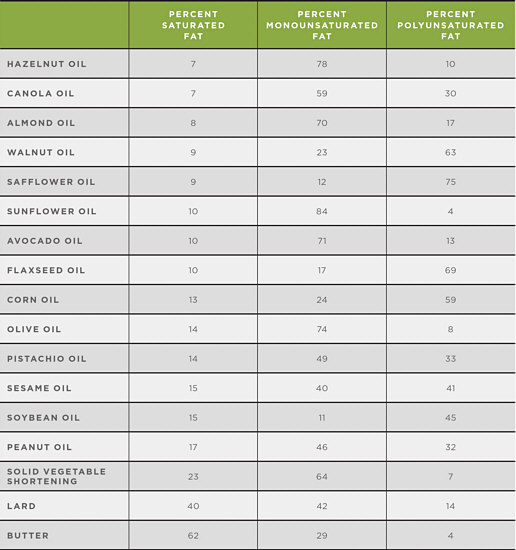Fat not only is key to sustaining life—our bodies require fat as an energy source—but also it is extremely important to the cooking process and to the flavor of dishes. There are, however, differences in the health risks and benefits associated with each type of fat. Here are some quick guidelines for the sensible use of fat in your cooking:
- When possible, choose liquid oils over solid fats (like butter or shortening). Solid fats are higher in either saturated fats or trans fats, which are the types of fat that have been implicated in a whole host of diseases. Oils, on the other hand, are mostly healthful unsaturated fats (with the exception of some tropical oils).
- In baking, although solid fats often produce the best results, experiment with substituting oil for some of the solid fat.
- Butter adds remarkable flavor to dishes. However, instead of using all butter in sauté-ing, use a combination of butter and oil. Or use all oil and then add just a very little bit of butter at the end of cooking, for flavor.
- Avoid margarines and butter blends or spreads that have trans fats.
- When choosing oils, choose those higher in monounsaturated fats and/or lower in saturated fats. See “Comparative Fats,” opposite.
TRANS FATTY ACIDS
To make vegetable oils solid at room temperature, thus making them more shelf stable, food manufacturers partially hydrogenate (add hydrogen molecules to) them. The process converts unsaturated fats to more saturated fats, creating something called trans fatty acids, or trans fats. Studies have shown that trans fats increase blood cholesterol levels and are even more unhealthful than saturated fats. For this reason, the United States Food and Drug Administration has mandated that trans fats be listed on food labels.
Vegetable Oils
Other than the choices you might make for health reasons, there are other factors involved in your choice of cooking or salad oil. (For more information on the flavor differences among oils, see “Salad Oils” on page 372.)
Unrefined oils: Most oils are refined by means of chemicals and high heat to remove solids, color, flavor, and aroma and to prolong shelf life. Unrefined oils have a much stronger flavor, a deeper color, and may darken even more at high cooking temperatures.
Expeller-pressed oils: These oils are pressed simply by crushing nuts or seeds. The only heat involved comes from the friction naturally produced in the pressing process.
Cold-pressed oils: These are expeller-pressed oils that are produced in a heat-controlled environment. The cold-press process is used for delicate oils that are particularly heat sensitive. However, because there are no regulations on the definition of cold-pressed, the use of this term on the label is not a guarantee that the oil is either expeller-pressed or unrefined.
COMPARATIVE FATS
Every type of fat, from lard to canola oil, is a blend of (primarily) three types of fats: monounsaturated, polyunsaturated, and saturated. The list below is organized by percentages of fat type, starting with those lowest in saturated fat—the least healthy type of fat. Margarines are not listed because with the huge difference among brands, you’re better off reading the label to determine the breakdown.

Toasted or roasted oils: Certain seed oils (such as sesame or pumpkin seed) and some nut oils are roasted before the oil is pressed out. These oils have very deep flavor and are best used in small amounts.
Vegetable oils: Many supermarket oils are simply sold as vegetable oil. They can be from a single source (such as soybeans or sunflower seeds) or they can be a blend of oils. To choose an oil that is high in healthful unsaturated fats, check the label, which should have the total fat broken down by saturated, monounsaturated, polyunsaturated, and trans fats. An oil that is high in unsaturated oils is one that is no more than 7 percent saturated fat. To determine the percentage, note the grams of saturated fat and divide by the total grams of fat. Keep in mind that the result will be a ballpark figure, since the gram amounts on the label are rounded-off numbers.
Nut oils: Nut oils can come both roasted and cold-pressed. The cold-pressed oils are most commonly found in health food stores; roasted oils tend to be found in high-end supermarkets and gourmet shops. The exception to this is peanut oil, which is readily available in supermarkets.
Storing Oils
As a general rule, oils that are higher in unsaturated fats (see “Comparative Fats,” page 111) go rancid more quickly than those with more saturated fats. Those oils are best stored in the refrigerator. Some clouding under refrigeration is normal.